Whenever I’ve done posts comparing the prices across different programs I’ve already found that JAL Miles are among the lowest, but today I’ll show you how to potentially double the value of these already great miles.
As you’ll see, I first try to figure out the rules preventing me from abusing maximizing this program with stopovers, stops in my home town, open-jaws, etc… Once I figure out the rules, I have ideas for loop-holes, then I do tests. Then I either find “deals”, or I find a new rule.
These fundamentals are things I’m going to apply to other distance based programs as I work my way across every program, which [oddly enough] I’m dissecting for my day job.
No one reads this site for the artful writing (-I can barely spell my name-), but I consider this unpublished rule dissection my art.
Hopefully you learn something about JAL miles that can open up an amazing trip, and learn something about program dissection.
Quick Overview
I recently did a post on JAL Miles Award Charts & Rules, which you can review to see all the award charts and rules.
For this post, I’ll spend more time explaining the concepts that would apply to each award chart.
It’s like most distance based award charts where you add up the total distance. And like many programs, there are a few different award charts, depending on if you’re flying a partner and how many.
Here is the JAL Miles OneWorld Award Chart:
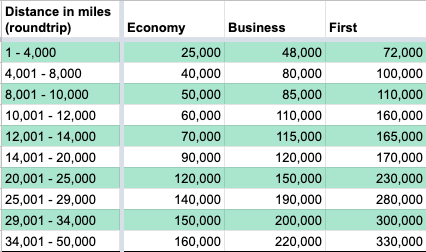
This chart is used when flying two+ partners, and the very similar Partner Award Chart is used when using your JAL Miles on a single partner award chart.
In the JAL Award Chart post, I included the below chart to show when the OneWorld prices are higher than the Partner Award Chart (red is when the OneWorld chart is more expensive):
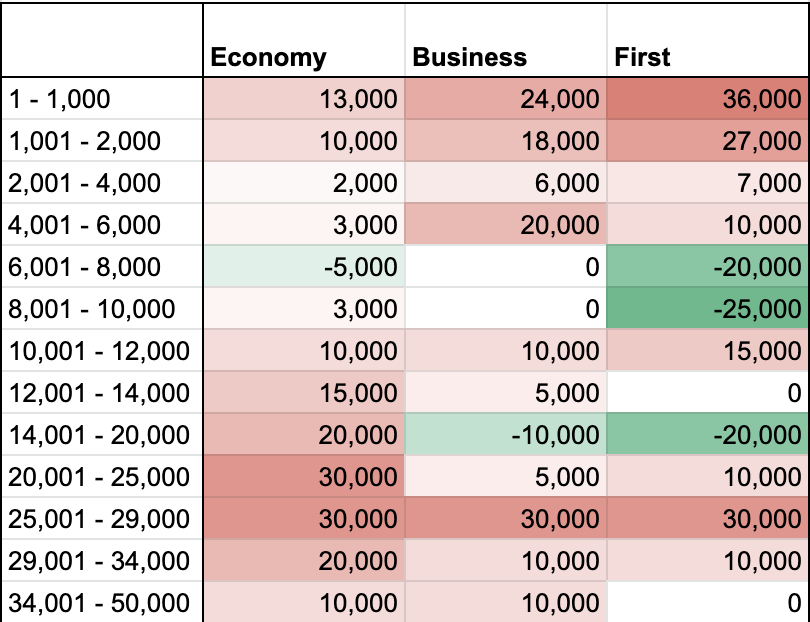
Still, for now, we’ll just be discussing the OneWorld award chart, but if it’s possible to use a single carrier, you can check to see which price is more expensive.
Efficiency Rating
A few days ago I introduced a concept called an “efficiency rating” in my post “British Airways Avios: Award Efficiency Rating“.
This is simply a cost per mile logic applied to the redeeming side. In the case of British Airways, it helps find the most efficient range to redeem your miles. That is, you’ll actually save miles with BA Avios is you were to redeem your miles for two 3,000 mile tickets rather than one 6,000 mile ticket.
For JAL Miles, it appears to be a lot simpler.
Here is the efficiency rating for JAL Miles’ OneWorld Award Chart:
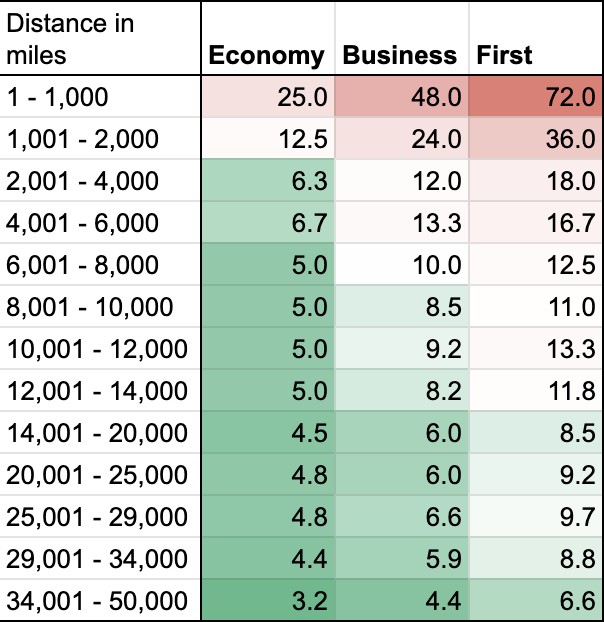
See, the more you fly, the higher value the ticket it. That is, a first class ticket at 34,001 flown miles or more is a better cost per mile than a 6,000 mile ticket.
JAL Miles: Stopovers & Rules
Here’s where we start to set up how things get interesting. First I’ll outline basic stopover info, then the rules, then how to get around them.
JAL Miles: OneWorld Award Chart written Rules
- Max of 8 sectors
- Only 2 sectors in Japan
- Max of 7 stopovers (including the destination)
- 1 open-jaw is allowed
Limiting to 8 sectors is very restrictive… Yet, I eventually show a route below that has 10 segments. Maybe it means to-and-from routes, regardless of segments, however, online it only gives you the option to add 6 “sectors” by that definition.
So let’s ignore that rule for now.
On the other hand, 7 stopovers (or really, 6 plus a destination) is amazing.
Their routing rules (which I’ll discuss further below) are extremely loose compared to a region based program because they price by distance.
AA miles want to restrict you from flying all over the earth because they’ll pay more and yet won’t charge more, as they only charge by the region-to-region price. Yet, JAL Miles would simply charge you more.
This means that you can essentially build round-the-world tickets with stopovers and see as much of the world as you want.
Plus, as we discussed, JAL Miles achieve a better value the more you fly.
Therefore for a roundtrip from Chicago with stopovers (meaning, as long as you want) in Madrid, Doha, Maldives, Bangkok, Hong Kong, Sydney, LA, and back… It appears it’s slightly over 26,000 flown miles and according to the award chart above, would cost 140k/190k/280k (econ/biz/first).
That’s an amazing value… if you have the time to stop in each of those places.
JAL Miles: Partner Award Chart written Rules
- Max of 6 flight sectors
- Max of 3 stopovers
- 1 open-jaw
Of course it’s nice to be able to use the Partner Award Chart when the prices are cheaper, however, you can’t do a lot of trips on a single partner.
But we will come back to this chart and how to maximize it as well.
Setting Up Extreme Maximizing
Longer Flights = More Value
As discussed with the efficiency rating, within each class, the more you fly the better value you get.
The big takeaway here is that if you could find a route with 34,001 flown miles or more, you are getting the most value out of JAL as possible, in each class.
However, most people can’t just fly to every continent on a single trip.
What I mean is, the only way to create a trip that gets close to 34,001+ miles is to fly to every continent on one trip, (which isn’t doable with most peoples’ vacation time allowances).
So, what if you could take multiple roundtrips from the same booking?
The Problem: Rules
The problem is that JAL Miles have put rules in place to keep you from using the same ticket to book a bunch of flights to/from the same city or even country.
Simply put, you can’t do US to Europe and back, and then do US to Asia and back on the same ticket. That would increase the miles flown and therefore get more value out of the ticket… However, the rules try to prevent this.
Beyond the rules above (listed in the terms and conditions), I found a few other consistent rules…
The other rules:
- Can not transit via region of origin (country?)
- You can’t do US to Japan to US and then tack on a segment elsewhere
- Can not transit via city of origin
- i.e. your first city has to be the last city
- Stopover is only permitted once per city
- Yet, I think you can connect through the same city twice as long as…
- Yet, it seems you can enter a city 3 times total, depending on if it’s a stopover or not
The reason they don’t want you transiting through your country of origin… is because you could just keep tacking on tickets at multiple dates.
You could just do New York to London and back this month, then New York to Japan and back… and while it would be two trips to you, on the JAL system you could book that in one ticket and take advantage of the fact that the miles price is a higher and higher value with more distance.
Let me rephrase: since the efficiency rating is better on longer distance trips, you could keep tacking on trips and getting a higher and higher value.
But, basically, they stop you from coming back through your country of origin and your city of origin.
But what if you just started from another region?
JAL Miles: Extreme Maximizing
I’ve been thinking of ways to get around these rules, and I’ve come up with a few tricks.
There are two main rules that prohibit making a bunch of roundtrips out of one ticket.
Rule 1) Whatever region you start in you can’t transit through again.
Again, you can’t just do US to Europe over and over on one ticket because it knows you started in the US.
Solution: Don’t start in the US.
What if you started your JAL Miles ticket in Mexico and did a stopover in your home town?
In other words, my suggestion is to start your JAL Miles ticket as a return home from another trip.
If you were to use another mileage program for a oneway to any place, and then use JAL miles home, you could stopover in your home country as many times as you want… simply because you started in another country.
For example, use AA miles down to Mexico, and then book a JAL Miles ticket from Mexico home, but make your home a stopover. Then you could later tack on a roundtrip to Europe, or Asia… or both!
I’m going to spend the entire rest of this post explaining how to do this and get around this rule.
Rule 2) You can only transit through a city once.
This is unavoidable and I haven’t thought of a way around this rule. Instead, you just have to use different cities.
For example, you could fly Argentina to New York, and then later, New York to Hong Kong… But when you return, you can’t return to New York, you’d have to return to Boston, DC, or anywhere not New York.
The only loop hole I’ve found is using an open-jaw to depart an airport again.
For example I did Argentina to NYC, then later NYC to Hong Kong. Since I’ve already flown into New York, I return to DC. However, it does allow me to depart New York City again!
You can only do this once, since you only get one open-jaw.
So my route searched was:
- Buenos Aires to New York
- New York to Hong Kong
- Hong Kong to DC
- New York to Doha
- Doha to Philadelphia
- Philadelphia to Madrid
And these routes can be any bookable date. You could return to New York tomorrow, and fly to Hong Kong 6 months from now, and it’s possible on one ticket.
By the way, that entire route would cost 160k/220k/330k (econ/biz/first), which is pretty awesome for all you get.
That’s the main concept, so let’s dive deeper!
An Extreme Example
Inspired by the search above, I tried another route.
- Mexico City –> DC
- DC –> Hong Kong
- Hong Kong –> New York
- New York –> Doha
- Doha –> Philly
- Philly –> Madrid
How I inputed the search:
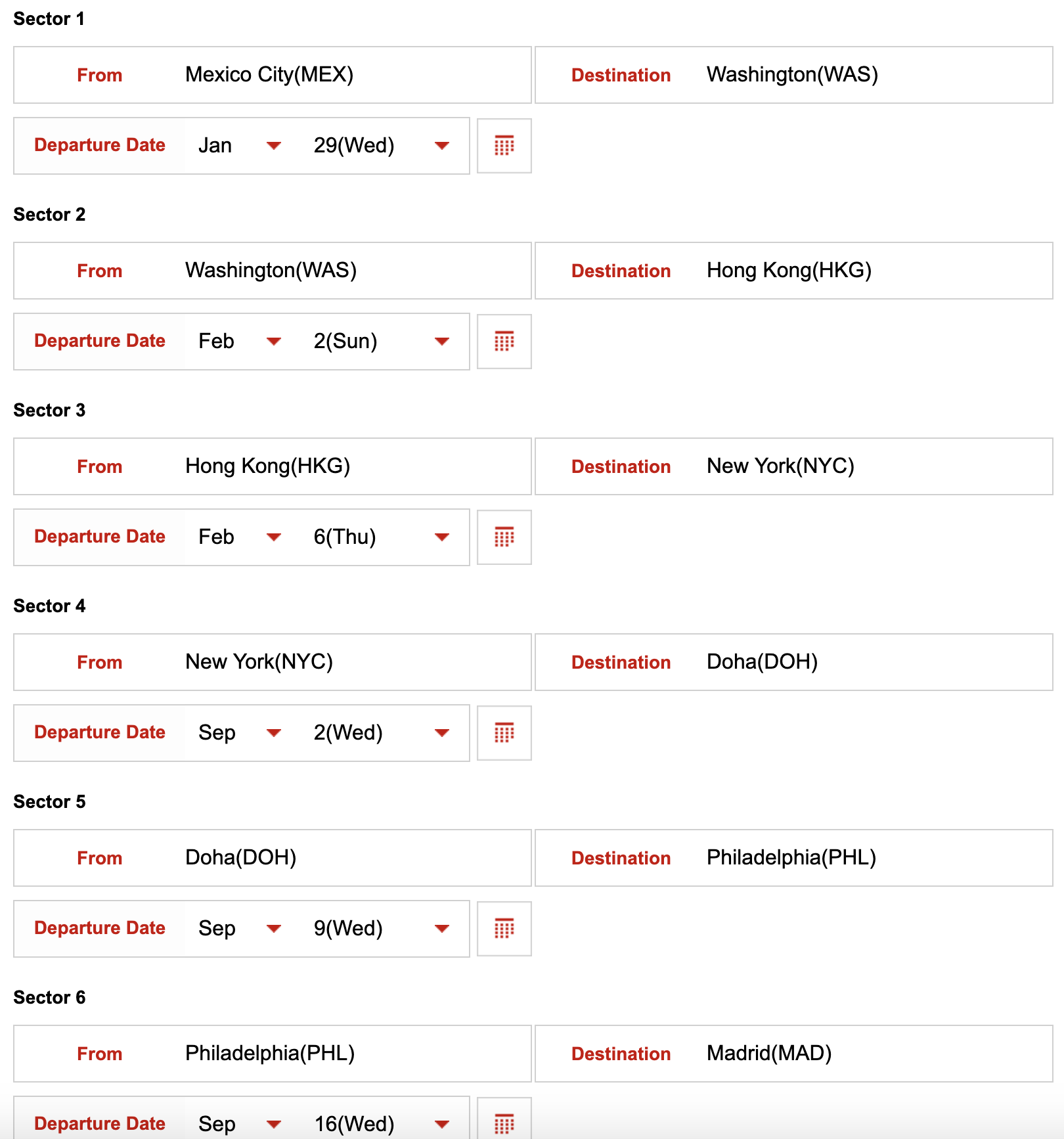
I tried to show a variety of dates to show how this could be broken up into multiple different trips.
And again, I had to switch cities because you can only stopover in a city once.
And by starting in Mexico I got around the rule preventing me from transiting through my country/region of origin.
Final results (in economy):
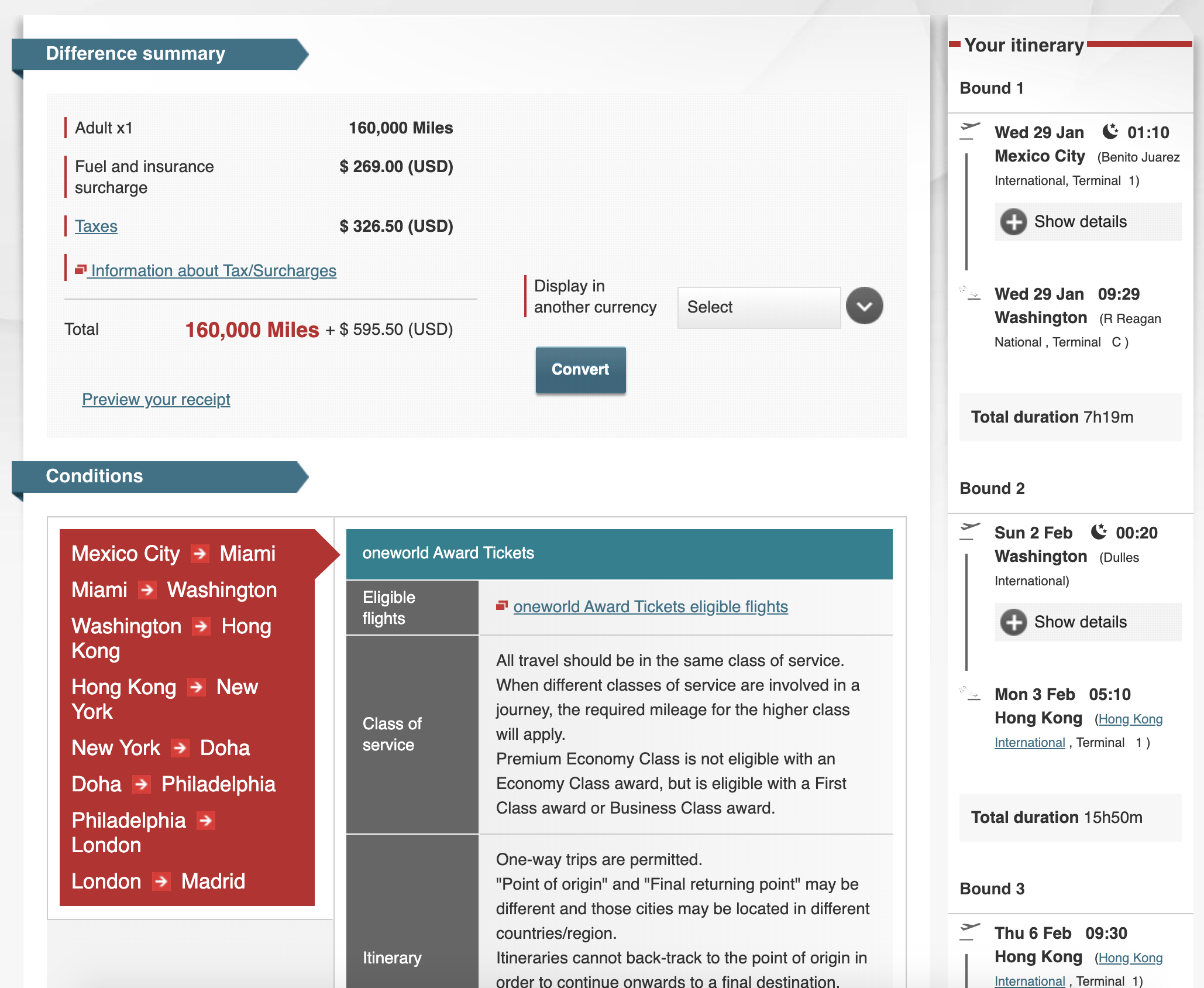
The total distance flown is 36,240 flown miles, which means it costs 160k/220k/330k (econ/biz/first) with the JAL OneWorld Award Chart.
(The fees in the above example are a little higher because I selected a British Airways flight to Madrid, which has huge fuel surcharge fees).
In the end, the route looks something like this:
I chose different colors for the different roundtrips to different destinations. My emphasis is that these can be different trips on one ticket, as you can choose any date you would like.
Why would you do this?
Assuming you can book multiple trips in the next 12 months now, you would get significant savings.
Let’s compare JAL (JL) to American (AA), Air Canada (AC), and United (UA) for this same route:
| JL | AA | AC | UA | |
| Econ | 160 | 197.5 | 205 | 212.5 |
| Business | 220 | 345 | 400 | 450 |
| First | 330 | 503.5 | 552.5 | 730 |
As you can see, the savings are substantial, especially as the class of service goes up.
The average first class price for this route is nearly double JAL.
Obviously, the biggest issue for booking these tickets in business or first is award availability.
This post simply isn’t about how to find premium award availability, but working with ExpertFlyer data lately, I see that there are regular chunks of OneWorld premium availability. Like I just saw a chunk of premium award availability to Brazil over Thanksgiving break. Posts about award availability could spark a trip like this.
For example, if you see a bunch of hard availability come up, then you could try to book a ticket with that trip in the middle and take advantage of where award availability is strongest: way in advance and last minute.
That is, if you see the Brazil award availability coming up, you could use miles to book a last minute ticket back home, and then book a big roundtrip way in advance. That way you have 2.5 roundtrips booked right there, in the times with the best availability.
(Check out our first podcast guest –> Spencer Howard on finding award availability).
JAL as separate tickets vs one big ticket
Now if you were to compare booking the JAL Miles this way (in one big ticket) vs booking as separate tickets, the savings doesn’t seem as dramatic.
This same route would cost 163k/312k/465k (econ/biz/first) as 4 separate tickets.
It’s still savings, as 330k is significantly cheaper than 465k in first (which is still a great price!), and economy appears to only be 3k cheaper.
I say appears, because you may run into a reality check when booking.
See, the big ticket I did above is already over 35,000 flown miles, which is the top tier. This means that the price can not increase. If I fly more or chose even longer distance destinations (like Brazil instead of Mexico), the price would not be the same. If anything, the value would go up.
However, if you were to book these tickets separately and you were routed via longer connections due to availability, your price would go up.
The example I chose and priced out in economy were mostly direct flights, which is why I picked those examples – for ease. But in reality, you could end up tacking on way more distance and increase the price.
In short, it could only be a small savings (like 3k), but it could be a huge savings – even larger than the 135k saving in First already.
Booking These JAL Miles Tickets
How to book:
- Link to book
- You have to sign in
- You have to select one of the three award charts to even do a search
- You can then add rows or sectors
General booking tips
- Add another sector
- It will auto match the last city to the first one, but you can click and delete them
- However, you can’t route through your city of departure, so you’d have to open-jaw on RT
It only really applies when OneWorld is cheaper than a single partner.

Booking with a single partner
You MAY be able to do the same thing with a single airline, like AA. You can check above where the prices might be better to use the partner award chart.
Remember, there are cases where the single “Partner Award Chart” is cheaper.
You go through the same process, but instead of selecting the OneWorld tab you select the “JMB Partner” tab.
Then you also have to select you plan to fly with.
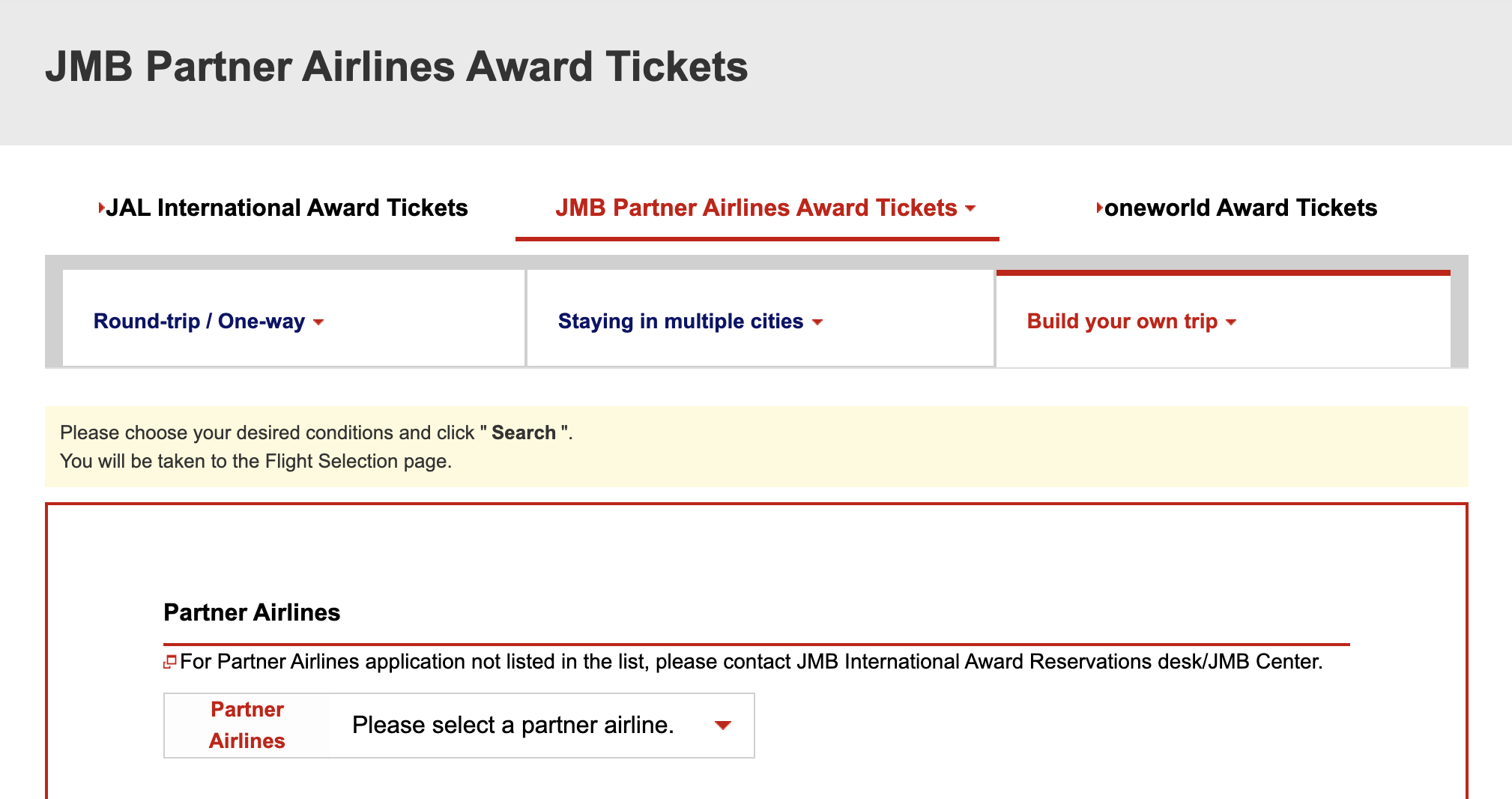
However, you’re limited to 4 routes per ticket with
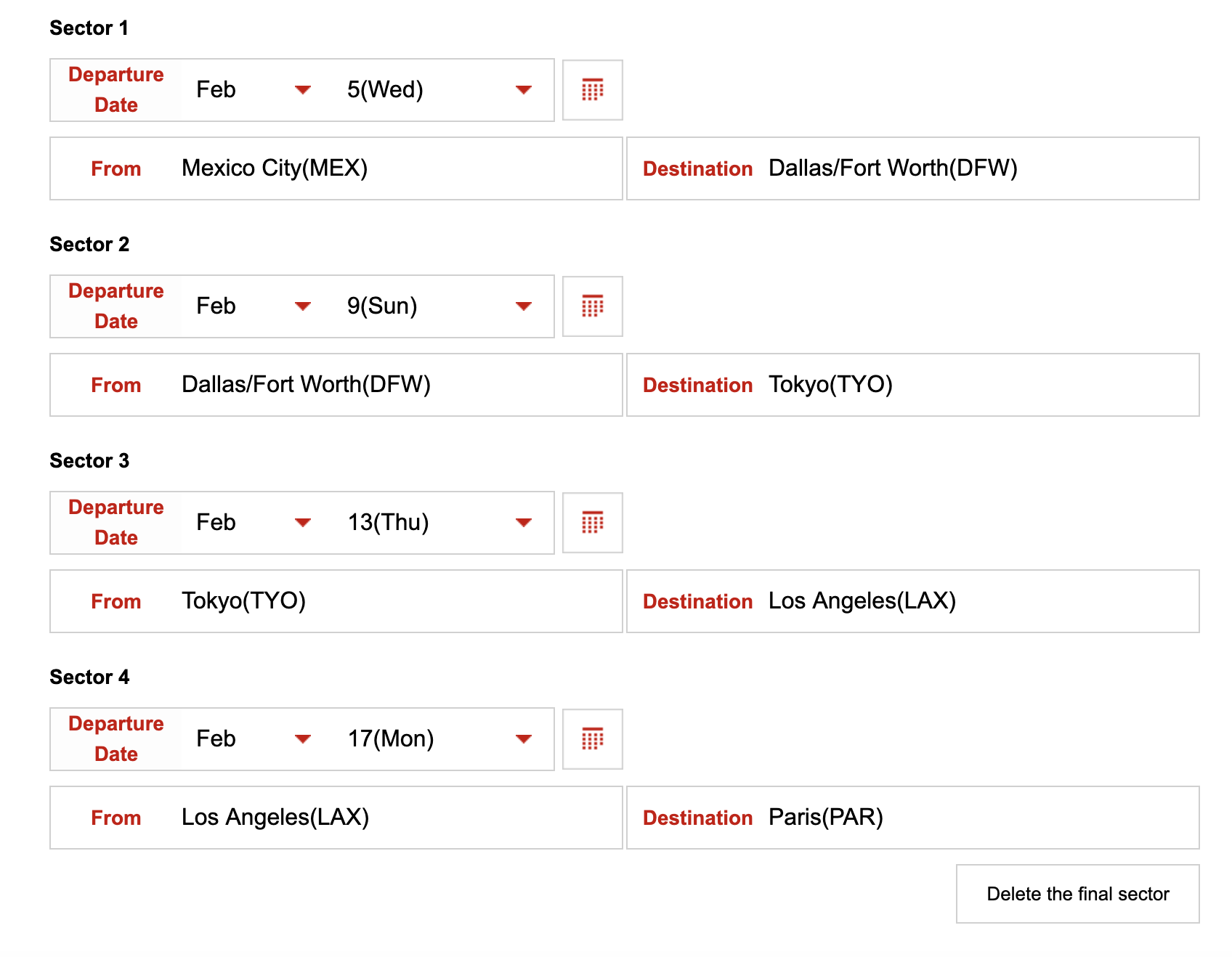
This could all be booked with AA:
Final proof:
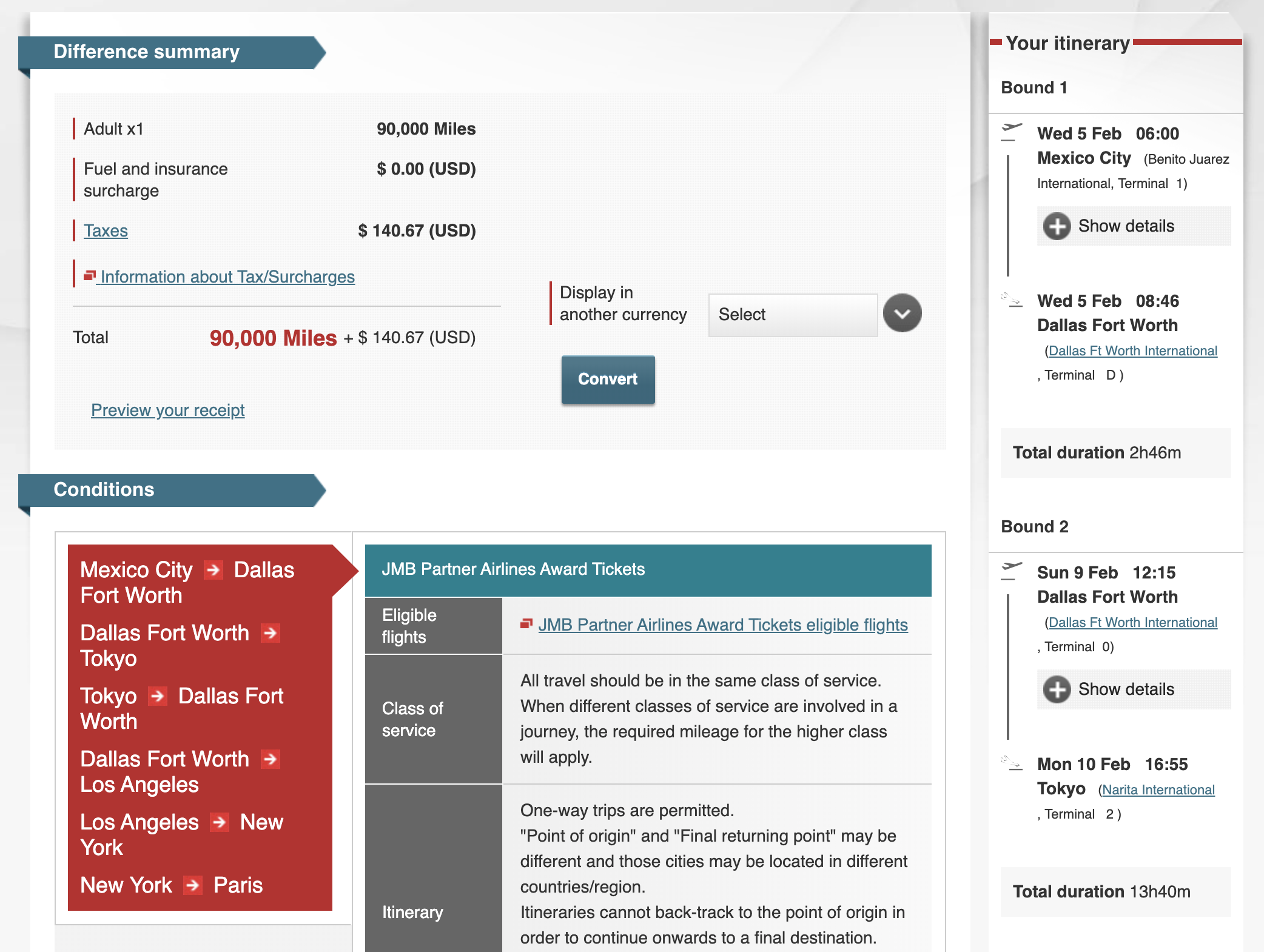
This is economy but would price out 90k/120k/170k (econ/biz/first).
How much is a ticket like this worth?
- Mexico to Dallas
- Dallas to Tokyo
- Tokyo to LA
- LA to Paris
This doesn’t get as high into the distance ranges (which have higher value) because we’re limited to 4 rows, and one airline. Perhaps if I had chosen Qatar and did a bunch of super long trips to Africa, the Middle East, or the Maldives, then it would be a super high value.
As it is, I think a roundtrip to Asia, and a oneway to/from Mexico and Europe is easily worth 120k in business class.
Conclusion
The more you fly, the higher the value.
In order to fly the most, tack on a bunch of roundtrips into a single ticket, which incredibly enough, counts toward the single total ticket price.
In order to have multiple roundtrips from your home country, you have to start the ticket as a return from another country. That is, use another mileage program to get to another country, and then start your JAL Miles adventure.
Believe it or not, in order to build the algorithm of my dreams (in an app we’re building), my job right now includes figuring out the rules for every single frequent flyer program. This was a result of poking around at my day job… and this is just one of the first airlines we’ve done. I hope to have a lot more like this. Hopefully I can return this blog to the glory days of trick-finding (2012 to 2015ish).
I hope people still enjoy this kind of heady content…
If so, please comment and let me know what you do or do not like and what lesser known programs I should do next!



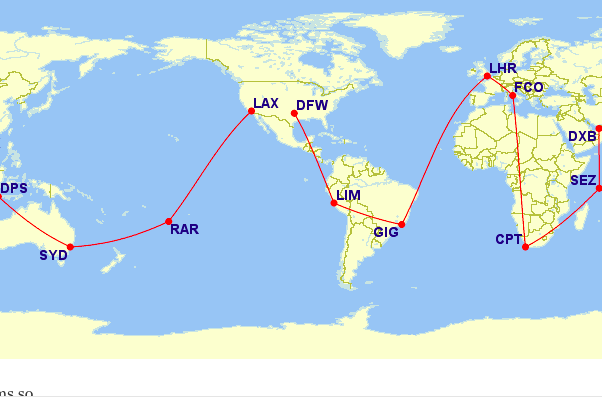
Very interesting. My daughter is in her final year of graduate school and needs to go to Panama, two months later to Cape Town, three months later to Barcelona, five months later Tokyo. I’m going to spend the next week playing around with JAL to see if I can make this work under one ticket. Dang this would be a fantastic money saver for us. Love this! Thanks! Now I’ll be clicking away for the next week or so trying to patch this together.
Wow. I wouldn’t imagine that people would have such a specific and practical reason to do this. 😀
Too bad JAL Miles aren’t easier to earn.
Keep it coming!
Thanks! Will do.
Whenever I see a post from you like this, I feel like a kid getting a new toy! Hands down, you put out some of the best and interesting info in this hobby. Thanks for this and everything else… Charlie
Thanks! I really appreciate the encouragement. Glad I’m getting more and more time to poke around for this stuff.
Drew,
You are a genius! Simply the only travel blogger with real content!
😀
Well, I appreciate the compliment! I will say, it’s easier to come up with original content when I don’t have pressure to write multiple times a day. Hopefully the content makes up a little bit for the lack of quantity! :-p
Very interesting stuff, and I look forward to more of these. If you’re shooting for smaller programs, I’d say keep going with the alliances, or maybe Virgin Atlantic.
Thanks for the feedback.
Last time I poked around in Virgin Atlantic I got Greg of FM to go to Necker Island. 😀 https://frequentmiler.boardingarea.com/considering-the-1-2-million-mile-necker-island-challenge-whos-with-me/
It’s always hit miss if I find anything though. Like these Asian program often have a ton of stopovers, which leads to these kind of finds. But I’ll take another look. I’m definitely going through all the alliance ones right now.
Dude, I don’t even have access to JAL miles but I love reading these posts. Keep em coming.
😀 Well, I’ll ask TPG if they can push Cap1 or something to add JAL as a transfer partner. :-p
Love this!
Thanks!
This is the content I was hoping for Drew! Great article
Glad to hear it! Hopefully I find more like this as I keep going through the charts.
This is why your content stands above anything else we see in the space. Nice job.
Thanks Tom! I appreciate the kind words!
Thanks for writing such a detailed walkthrough of the JAL mileage program. While I don’t think it is likely I’ll use this information at any time in the near future, it is great to know what is possible and this is the kind of content that I wish more people turned out.
LOVE IT. Thanks Drew for continuing to write here. I hope you’ll walk us through this in more detail your next podcast. Are you planning to actually book one of these itineraries?
If you keep content like this coming, nobody will accuse you of “selling out” again 🙂
It is going to take me some time to digest it and most likely I do not have usage with it because JAL miles are hard to come by. However I like this kind of post a lot because it is new and innovative. I just need to sit down and concentrate to follow your instructions. Thank you very much.
Btw, I like the podcast with Dave sharing his story in Japan. The key thing I remember is the presence of Dave’s daughter on the trip kept him from wrongdoing multiple times.
Delicious!! Always appreciate your content and level of detail.
Thank you Drew, I really enjoy reading and learning about this. How about ANA next? Thank you again.
P.s when is next podcast with the Bike Guy.? I have been waiting for a long time.
Posts like this are classic. Thanks. As to other programs, maybe one that’s comparatively easy to get miles through partnerships?
What about border towns between Canada/USA?
How many miles would SEA-NRT-YVR-HKG-SEA be?
Is that a valid routing? It’s essentially two trips to Asia
Thank you Drew for this post–I’m book-marking. I’ve been hoarding SPG points for years planning my someday around-the-world trip for 2 in first class. I’ve got over 600,000 miles (which translates to 750,000 JAL miles). I realize business class is really the sweet spot (what an amazing deal for 34K-50K), but hey–it’s my dream trip. And your article unlocks how to turn this into a series of trips rather than one long trek. Thanks for doing this. And I am SO glad you are still moonlighting at TIF!
I have seen ideas like this in other blogs, but, as always, can never acquire these miles.
What’s your day job now? Weren’t you doing a pier to pier tools rental business?